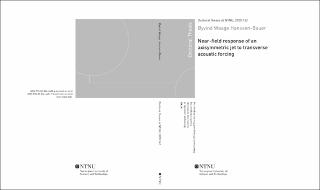| dc.description.abstract | The overall aim of this thesis was to investigate a transversely forced, round air-jet, with focus on the coherent vortex structures formed in the near-field of the jet. Increased knowledge about the interaction between the acoustic field and the simple, round jet is relevant for industrial flow scenarios such as thermo-acoustic oscillations in gas turbine combustors. A series of experiments were conducted placing the jet at different positions in a standing-wave pressure while performing stereoscopic particle image velocimetry.
It is known from previous studies that at the pressure anti-node position, where only axial velocity fluctuations are present, the shear-layer of the jet rolls up into axisymmetric vortex rings. At the pressure node position on the other hand, where only transverse velocity fluctuations are present, the shear-layer rolls up into vortex structures that are in anti-phase on either side of the jet centerline in the direction of the pressure wave.
The results in this thesis suggest that it is the velocity fluctuations at the nozzle exit, either axial, transverse or a combination of both, that drive the formation of the vortex structures in the jet. These structures start to form when the velocity at the nozzle exit turns positive in the cycle; either out of the nozzle in axial direction, or away from the jet centerline for the transverse direction. Vortices formed by transverse fluctuations are found to pinch off one half of the forcing period later, when the jet turns away from the vortex. For positions close to the pressure anti-node, the presence of moderate amplitudes of transverse velocity fluctuations causes the vortex rings to tilt. For the positions between the pressure anti-node and the pressure node where both velocity fluctuations are present with comparable amplitudes, the jet forms complex vortex structures that can be fundamentally different on either side of the jet. Here the phase between the velocity fluctuations seems to play an important role; either one vortex is formed in the shear-layer if the axial and transverse fluctuations are approximately in phase, or the velocity fluctuations form separate structures at different times in the cycle if the phase difference is sufficiently large. | en_US |
